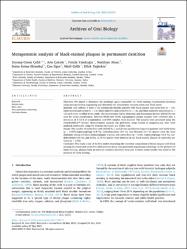Metagenomic analysis of black-stained plaques in permanent dentition

View/
Date
2021Author
Çelik, Zeynep CerenÇakiris, Aris
Yanıkoğlu, Funda
Abacı, Neslihan
Ekmekçi, Sema Sırma
Ilgın, Can
Çelik, Halil
Tağtekin, Dilek
Metadata
Show full item recordCitation
Çelik, Z. C., Çakiris, A., Yanıkoğlu, F., Abacı, N., Ekmekçi, S. S., Ilgın, C., Çelik, H., & Tağtekin, D. (2021). Metagenomic analysis of black-stained plaques in permanent dentition. Archives of oral biology, 128, 105171. DOI: https://doi.org/10.1016/j.archoralbio.2021.105171Abstract
Abstract
Objectives: We aimed to determine the aetiologic agent responsible for black staining of permanent dentition using next-generation sequencing and determine the relationship between caries and black stains.
Materials and methods: A total of 52 systemically healthy patients with black-stained and caries-free (n = 13), black-stained and carious (n = 13), black stain-free and caries-free (n = 13), and black stain-free and carious (n = 13) teeth were enrolled in the study. The International Caries Detection and Assessment System (ICDAS II) was used for caries classification. Between 08:00 and 10:00, supragingival plaque samples were collected after a minimum of 8-12 h of accumulation and DNA samples were isolated. The samples were processed using the ZymoBIOMICS™ Service. Bioinformatics analysis was performed using mothur at usegalaxy.org. Data were analysed statistically using the Pearson chi-square and Fisher tests.
Results: The number of caries-free teeth (ICDAS 0, 1, and 2) was significantly higher in patients with black stains (p = 0.007).Capnocytophaga (4.8 %), Corynebacterium (3.9 %), and Neisseria (5.4 %) species were the most abundant among all black-stained plaques (carious and caries-free) (p < 0.05). Capnocytophaga (10.8 %), Cardiobacterium (3.6 %), and Rothia (1.72 %) species were detected in the black-stained plaques of caries-free patients (p < 0.05).
Conclusion: This study is one of the first studies examining the microbial composition of dental plaques with black staining in carious and caries-free adult patients using next generation sequencing technology. In the presence of black staining, plaques have an ultimate complex microbial structure. A lower caries burden was noted in the presence of black staining.

















